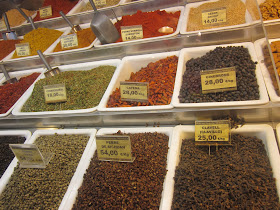Es fascinante como que algunas
famosas tartas y postres tienen sus únicas historias de creación lo que añade
personalidad y hace que sean mucho mas especiales y con una calidad dimensión
humana.
La historia de esta tarta comenzó en
1832, cuando Wensel Clemens Prince Metternich, ordenó la creación de un manjar
digno para sus invitados de alto rango.
El destino intervino aquel día, ya
que su chef estaba enfermo así que la creación de esta tarta fue encargada a un
aprendiz de 16 años en su segundo año de estudios, al perspicaz y talentoso
adolescente Franz Sacher.
La receta que creó fue un éxito
total: una tarta suave y esponjosa con deliciosa mermelada de albaricoque
debajo de una estupendo cobertura de chocolate.
Cuando Sacher llegó a ser un
cualificado chef profesional y a trabajar por su cuenta ofreció su creación al
gran público, La tarta tuvo una inmensa acogida y un éxito irrebatible y luego
fue nombrada Sacher Torte, en honor a su creador.
Se dice que la receta original del
Sacher es un secreto bien guardado por el Hotel Sacher, sin embargo muchos
intentaron recrear la receta, algunos tuvieron éxito y algunos no tanto. En
internet abundan cientos y cientos de recetas, aquí pondré la receta que yo
hice ya que el resultado fue muy bueno.
Hace casi 10 años, estaba en Viena,
la cuna de esta tarta, y quise probar ese famoso manjar, así que visité una de
la más famosas cafeterías de la ciudad que por desgracia ya no me acuerdo del
nombre, eso sí recuerdo todas las sensaciones de aquel momento. Una delicia disfrutada
en una ciudad encantadora y Bourgeoise!
Probé varias recetas del Sacher y
voy a compartir la que me llevó otra vez a sentir aquella experiencia Vienesa,
y me atreví a añadir pequeños detalles personales lo que hizo que la tarta sea
todavía más diabólicamente deliciosa.
 |
| El resultado de un trabajo duro: Un postre de lujo! |
Y lo que necesitamos:
- 175 gr chocolate negro
- 150 gr mantequilla blanda
- 100 gr azúcar
glas
- 6 huevos, separados
- 60 gr azúcar
- 150 gr harina (tamizarla varias
veces, es una tarta esponjosa y así tendremos una tarta mas delicada)
- 1 cucharadita de vainilla
- Pizca de sal
- Mermelada de alabricoque
Nota:
Yo usé 4 huevos en vez de 6, solo hay que calcular la cantidad requerida para
cada ingrediente por cada huevo
.jpg) |
| La tarta recibiendo su baño de chocolate! |
Y para la cubertura se necesita:
- 200 gr
de chocolate negro
- 200 gr
de azúcar
- 100 ml
de agua
- 1
cuchara de jarabe de maíz
Y manos a la obra:
Con un
baño maria derrite el chocolate, añade la mantequilla y mezcla bien hasta que
se quede cremoso.
Agrega el azúcar glas y mezcla muy bien. Incorpora
la yema del huevo, una a una, y bate bien hasta que la mezcla se quede
homogénea.
Ya
puedes añadir la vainilla, y algo opcional, una cuchara de whisky, yo lo hice
porque quita cualquier sabor indeseado de los huevos y da un toque especial.
(En
otras recetas se bate la mantequilla hasta que se quede blanda y cremosa luego
se le añade el azúcar glas, siguiendo luego los mismos pasos. He probado los 2
métodos y el resultado no varía)
Poco a
poco, añade la harina y mezcla bien hasta que esté bien incorporado.
En un
bol grande, bate las claras con el sal, hasta punto de nievo, agrega el azúcar
y batir hasta que se quede firme, también puedes añadir un poco de vainilla o
algo de alcohol por quitar el olor de los huevos.
Empieza
a añadir las claras a la mezcla del chocolate, añade un poco y mezcla para que
el chocolate se queda mas liquido, luego añade las claras en 3 o 4 lotes, con una espátula y removiendo, de abajo a
arriba, lo justo para que se incorpore.
Divide la mezcla en 2 moldes de 18 cm, cubiertos con papel
para hornerar, mantequilla y cacao en polvo, y hornea en un horno precalentado
a 180 C durante 18 a 20 minutes.
Deja enfriar antes de quitar el papel. Prepara la mermelada
(unos 200 gr), calentándola a fuego lento, se puede añadir ron moreno o lo que
añadi yo fue ron blanco y un poco de whisky.
Unta una de las tartas con la mermelada y luego añade la otro
( yo añadí con la mermelada ganache de
chocolate, inexistente en la receta original , hecho con 130 gr de chocolate y 70 ml de nata). Pasa la mermelada
por un colador y unta toda la tarta. Deja reposar durante un poco de tiempo.
 |
| Una vista irresistible |
Mientras prepara la cobertura. Combina el azúcar, el agua y
el árabe de maíz, a fuego lento deja q el azúcar se derrite, luego deja hervir
durante unos minutos.
Fuera del fuego añade el chocolate troceado y no mezcles
hasta que se derrite.
Después de
mezclarlo bien y tener un chocolate liquido pero consistente, deja enfriar 2 a
3 minutes y a cubrir la tarta, puesta sobre la rejilla, con esta mezcla
majestuosa de chocolate.
Pincha con un palillo cualquier burbuja que se pueda ver en
la cobertura, y intenta no mover la tarta de la rejilla hasta que el chocolate
haya secado bien.
He decorado mi tarta con perlas de azúcar doradas y con gotas
de chocolate que hize con ayuda de un cornete de papel, y con lo mismo escribí
Sacher!
 |
| Un color que va muy bien con un postre tan rico |
 |
| Y a disfrutar de una porcioncita! |
Y listo, buen provecho!!!

.jpg)















































.jpg)


